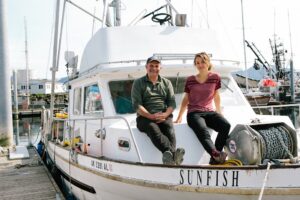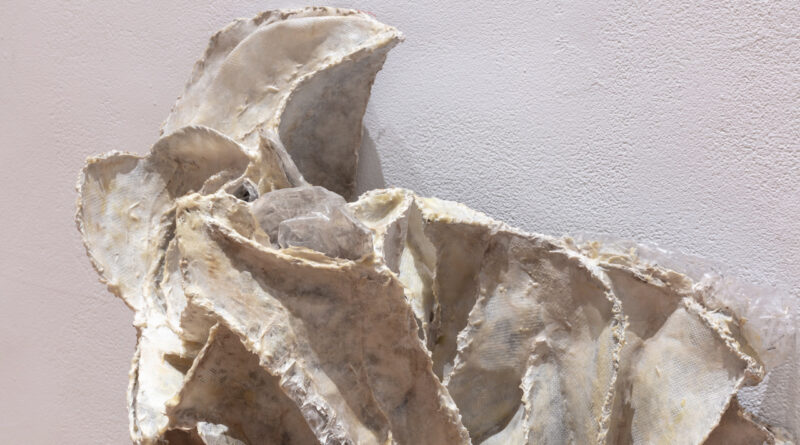Climate Art and Science Disrupted
Podcast: Play in new window | Download (Duration: 1:58:27 — 55.9MB)
Subscribe: Apple Podcasts | Spotify | Android | iHeartRadio | Podchaser | Email | TuneIn | RSS | More
(January 31, 2021) It was more than a year and a half ago that we welcomed Christine Esposito to this show. She was beginning work on a project called Third Coast Disrupted: Artists + Scientists on Climate. The idea was to get artists, scientists, policy-makers and more to interact, with the goal of addressing climate change. Then, this thing called “a pandemic” happened, leaving climate art and science disrupted, so to speak. We’ll get to that in part deux of this blog.
Sustainable fishing and Sitka Salmon Shares
First, however, we focus on the disruption of life and food in the largest ecosystem on the planet–our seas. To do that, we welcome back Nicolaas Mink, Ph.D., though to us he’s just “Nic.” Mink is the CEO and a co-founder of Sitka Salmon Shares. It’s a direct-to-consumer seafood company that is a leading provider of premium wild Alaska seafood to home cooks in the United States. It is also a community supported fishery (CSF). Here’s how they explain it.
 When we started, there were around 20 CSFs, now there are considered to be 75 to 100 in North America. While CSFs come in a number of shapes, sizes, and with different business models, a true CSF should be anchored by a triple-bottom line approach that embraces environmental and social impact alongside financial profitability. Bolstering fishing livelihoods, supporting the health of coastal communities, protecting our oceans, building deeper connections between consumers and harvesters, and strengthening regional food systems remain key components of what it means to be a CSF.
When we started, there were around 20 CSFs, now there are considered to be 75 to 100 in North America. While CSFs come in a number of shapes, sizes, and with different business models, a true CSF should be anchored by a triple-bottom line approach that embraces environmental and social impact alongside financial profitability. Bolstering fishing livelihoods, supporting the health of coastal communities, protecting our oceans, building deeper connections between consumers and harvesters, and strengthening regional food systems remain key components of what it means to be a CSF.
That’s one of the reasons why Sitka Salmon Shares has been a sponsor of this program (in full disclosure) for several years. We like their mission and their operation. I like it enough to have purchased several shares. We also like having Nic on the show to talk about sustainability. As an instructor of Environmental Studies at Knox College in Galesburg, Illinois, he teaches courses on sustainable food systems, natural resource management, and environmental history.
Social and environmental justice is in that mix, too. You might want to check out this page on the SSS site: How You Help Us Build a Better Seafood System. You’ll find out about the company’s investments in transparency, environmental stewardship, responsible harvesting and fair wages. Peggy and I always learn a lot when he stops by.
Of course, “stopping by” is a relative term during these COVID days. Today, Nic brings us up to speed with changes in the Sitka Salmon Shares organization since the last time he talked to us, about eight months ago. That includes the launch of a program they call the Freezer, partnerships with folks like comedian Charlie Berens and his Manitowoc Minute, and the Wild at Home cooking show.
I’m going to make sure that we also revisit an issue that Nic touched on during a couple of earlier appearances on the show–the threat posed to Alaska’s Bristol Bay by a proposed gold and copper mine. Strangely enough, the mine was defeated by the Trump administration. Go figure. You’ll find that story interesting.
Climate art and science disrupted in Chicago
Now back to Third Coast Disrupted: Artists + Scientists on Climate. You can watch a virtual tour of the exhibition here. and see photos here. You can even watch interviews of the artists talking about their works and the scientists giving context for them.
Christine Esposito, who we mentioned earlier, is Project Director & Lead Curator. She founded Terracom some three decades ago, and recently created the Ex.Change Project to use the power of science-inspired art to build awareness of and spur action on critical environmental issues. Third Coast Disrupted is one of those efforts. Here’s how she explains it.
Through science-inspired sculpture, painting, collage and more, the artworks examine local impacts — happening here and now — ranging from extreme heat to flooding to habitat loss, and more. They also shine light on local solutions underway, like “cool roofs,” nature-based approaches to slowing stormwater, and backyard habitat restoration. Some imagine future possibilities.
Third Coast Disrupted is based on the notion that art can connect and engage with people on an emotional level. It can pique curiosity, be unexpected, tactile, interactive, evocative, and memorable. It can slow people down, inspire them to reflect, move them to talk to each other — and spur them to act.
We’re rapidly coming to the end of the exhibition, which opened on September 8, 2020, in the midst of the COVID-19 pandemic. More on that in a moment. Today, we talk plastics, which is the subject of an installation by artist Barbara Cooper. She works with diverse materials, including wood, metal, paper, glass and found objects. Regarding the installation about plastics, she writes,
This work formed around a question: Can the earth, the atmosphere, and the multitude of earth-bound organisms “digest” what humans generate from an increasingly toxic industrial complex? I am referencing the escalating use of plastic and the pervasive and perverse trail it leaves throughout the earth’s ecosystem.
As plastic breaks down, the microscopic particulates it leaves behind are now found within all parts of the environment. They are so embedded within our life support systems as to be inseparable from them. These sculptures reference the body systems that allow us to absorb food, water, and air, all of which have been found to harbor surprisingly large amounts of micro plastics.
![]() Check out the fascinating and terrifying artifact on the left, something called “plasticonglomerate.” The caption reads:
Check out the fascinating and terrifying artifact on the left, something called “plasticonglomerate.” The caption reads:
Found on Kamilo Point Beach, Hawaii: “plasticonglomerate,” a type of rock formed when plastic debris–perhaps in a campfire–fuses with sand, rock, shells, and coral. Geologists think it may become an enduring marker of our impact on the earth.
As part of Third Coast Disrupted, Plastics will be featured in an online conversation on Thursday, February 4 called Breaking Down Plastics. Building up Solutions. It features artist Cooper; Timothy Hoellein, Associate Professor at Loyola University; and Tyrone Dobson, Senior Volunteer Engagement Manager at the Alliance for the Great Lakes. Dobson oversees all of the Alliance’s volunteer programs, which includes Adopt-a-Beach, which engages over 15,000 volunteers in beach clean-ups across the eight-state Great Lakes region; the Chicago Ambassador program, and the Alliance’s Chicago Young Professional Councils.
In a brief conversation I had with Cooper and Dobson the other day, Dobson highlighted the role that the consumer can play in reducing plastic consumption and pollution. At the same time, I saw this article in the New York Times about an effort to strengthen extended producer responsibility (EPR) laws. That would put the onus more squarely on manufacturers. Frankly, it’s going to take an “all of the above” approach to keep us from drowning in plastic. That includes adding “refuse” and “rethink” to the “Three Rs”: reduce, reuse, recycle.
Speaking of climate art and science disrupted, I mentioned earlier that the middle of a pandemic might not be the best time to start an art exhibition. Esposito writes,
It impacted our artist-scientist salons, which were going to be at various sites. Our first was at the Field Museum, the second was at the studio of Hector Duarte (one of our artists). But the last two had to be via Zoom. It impacted plans to involve community members in creation of some of the artworks — had to eliminate that, sadly. Installation of the exhibit was more intensive for the exhibitions manager, since fewer people could be in the gallery at a time. So he had to carefully schedule the artists. And of course, it meant the gallery had to be closed for a period. Actually, the originally closing date was 10/30, and the gallery remained open that entire time, though it had fewer visitors than it typically would have, with people being understandably cautious. The gallery extended the show through Feb. 19. It was closed for 1 1/2 to 2 months during that time. (I don’t recall exactly how long it was closed, but it was a stretch.)
The home stretch starts tomorrow, February 1. Here are the details.
Third Coast Disrupted:
Artists + Scientists on Climate
February 1 – February 19, 2021*
Glass Curtain Gallery – Columbia College Chicago
1104 S. Wabash Ave., 1st Floor, Chicago
Gallery Hours: Mon–Fri, 9 am – 5 pm
Gallery capacity is 10 visitors. Masks are required.

